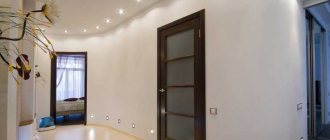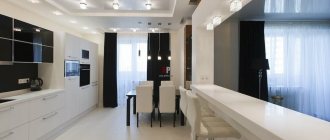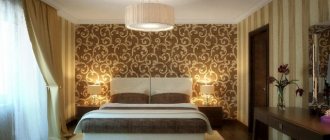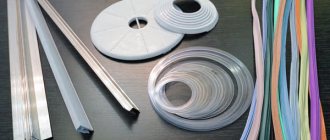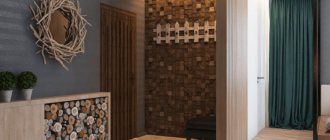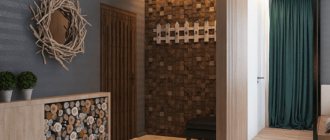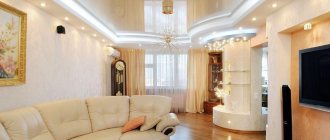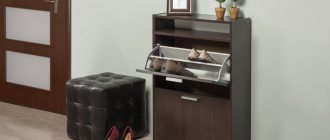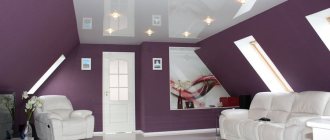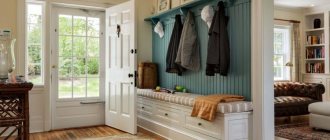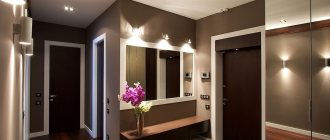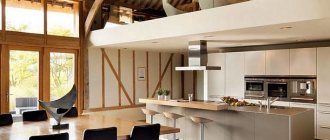Selecting a canvas
Stretch ceilings are made from two types of materials: fabric and film. The first is a dense weave of threads impregnated with polymers for strength. Fabric fabric is more durable. But there are much fewer color options than film. But it can be painted several times.
The fabric has another drawback. It gets dirty faster (due to its mesh structure) and is more difficult to clean: only the dry method is suitable. More dirt from the street gets into the corridor than into other rooms. Therefore, fabric ceilings are not the best choice.
The film sheet is made from polyvinyl chloride. The material is damaged by sharp objects. But it retains water in case of a flood and is easily cleaned with mild detergents. The maximum roll width is 3.3 meters. For standard corridors and hallways this is enough; there is no need to connect several canvases.
PVC film is available in different types of textures. Gloss reflects light best, thereby creating a mirror effect. This surface is selected for low rooms, including hallways with stairs in private houses. The smooth texture has the widest range, including dark, pastel and bright shades.
The matte ceiling does not produce glare. Colored surfaces are more saturated. In pastel color it serves as an excellent background for other furnishings.
The satin surface is similar to fabric. An unobtrusive shine appears due to partial refraction of light. The shade of the ceiling changes slightly at different distances from the lamps. The surface resembles mother-of-pearl.
Design options
Stretch ceilings differ not only in material, but also in the number of levels. The simplest and best option for hallways is a canvas stretched in one tier.
A more complex design - two levels. It is created in the following ways:
- A plasterboard box is erected (this is the lower tier), and a canvas (the upper tier) is stretched from it to the walls. Both fabric and film are used.
- They make a complex frame at different heights and stretch the canvas. With this method, only film is used, since it is more elastic.
The following designs are often found:
- one or more “tablets” - in the shape of a circle, flower, cloud, etc. (spotlights are often built into them);
- perimeter frame;
- division along or across the ceiling, straight or wavy;
- rings.
You don’t have to limit yourself to two levels; you can do three or more. But with each new tier the ceiling height will decrease (by 10-15 cm for the first and at least 3-5 for each next).
In a cramped hallway or narrow corridor, such designs will look out of place.
Color solutions
As a rule, hallways are modest in size. Therefore, light shades are chosen for them.
White color is traditional. The matte texture is practically no different from leveled and plastered. It looks more interesting in satin or gloss. Combines with walls and floors in any color.
Beige has a similar effect to white, but looks cozier. Available in different shades, cooler or warmer.
Light gray also goes with others and expands the space. But it looks more strict.
You can choose delicate pastel shades. For example, blue tones are often chosen. They remind you of the sky and sea, but the room seems cooler. Light green, lavender, ivory, etc. are also suitable. You need to ensure that the suspended ceilings in the hallway are combined with the rest of the decor and style.
Bright colors should be used sparingly as they make the room feel cramped. However, such paintings can become the main accent in the interior. They are used for spacious halls.
It is also possible to combine colors. As a rule, for multi-tiered structures, different tones are chosen to emphasize the level transition.
Types of suspended ceilings for hallways
In fact, suspended ceilings are much older than they might seem at first glance. They began to be produced in Sweden back in the 60s, but then the technology was not practical and perfect enough. After 20 years, the French improved and modernized it - and that’s how the stretch ceilings we see today appeared.
Since then, many new materials, textures, drawing technologies and installation methods have appeared. But as a tribute to the past, stretch ceilings are still called French.
Glossy stretch ceilings
For a hallway, reflective mirror gloss is an ideal choice, because it visually increases the height and volume of the room by almost doubling. Such ceilings reflect light, so the room will be lighter and airier. And if you are the happy owner of a large and spacious hallway, use gloss as a separate element of a multi-level design.
Matte stretch ceilings
At first it may seem that a matte finish is no different from regular painting. But its main advantage is that it looks much neater and will definitely not crack over time. And when designing complex designer interiors, you won’t have to worry about unexpected light refractions and combinations of textures. Matte stretch ceilings will fit everywhere: from classic to ultra-modern high-tech.
Satin stretch ceilings
If you don’t like shiny mirror coatings, and a matte stretch ceiling seems boring, take a satin fabric. Delicate, graceful and slightly shimmering, it resembles the fabric of the same name with its silky texture. An interesting feature of the coating is the play of light and shades, depending on the brightness and type of lighting.
Stretch ceilings with photo printing
The manufacturing features of film for suspended ceilings allow you to print any designs on it. You can take full advantage of this to create a unique designer interior in the hallway. These can be neat monograms, traditional floral patterns, or even entire paintings or photographs.
Fabric stretch ceilings
To create suspended ceilings, not only modern PVC film is used, but also ordinary fabric impregnated with wear-resistant and moisture-resistant compounds. Textiles fit nobly into complex decorative interiors: baroque, rococo, and elaborate oriental styles. This is a completely natural and environmentally friendly coating that allows air to pass through and delights with a variety of textures.
Hallway Lighting Tips
This room has two features: the lack of natural light and its elongated shape. Properly selected and positioned lamps can compensate for shortcomings.
It’s better not to hang a chandelier, but to make several spotlights. This way it won't be dark in the corners. Location options:
- in a row along the corridor;
- curved line;
- arc;
- rhombus, etc.
Important! Incandescent light bulbs are not suitable for suspended ceilings, as they heat up too much and can damage the ceiling. Therefore, LED, less often halogen or energy-saving lamps are used. This way the temperature around the spot does not rise too much.
Another lighting method is LED strip lighting (around the perimeter or between levels). Used separately or together with the previous option.
The luminous stretch ceiling in the corridor looks interesting. To create it, a translucent film and diodes located behind the surface are used. Not the entire ceiling can glow, but individual lines on it: straight or figuratively curved.
Photo printing on canvas
A glossy or matte stretch ceiling in the hallway can be complemented with an original design, realized through the use of photo printing technology.
Such exclusive decoration of the room will not go unnoticed by the guests, but the design must fully correspond to the idea of arranging the room and the theme of the design.
Accent ceiling in the hallway
The non-standard surface attracts the eye. For walls, floors and wardrobes, choose calm neutral shades to avoid variegation. But even so, the solution is suitable for more spacious corridors. And in small ones it is better to adhere to minimalism and not make the ceiling the main decoration.
With photo printing
The image is applied to all types of materials and textures. The designs look more naturalistic on a matte surface without shine. An interesting effect is obtained on fabric or satin - like a painting on canvas.
For hallways it is not necessary to choose an image in the entire canvas; it is better to leave them for large rooms. A ceiling with a pattern in the corner or a discreet ornament would be more appropriate. The subject can be any, but abstract is more suitable.
Dark
Such colors visually reduce the height of the ceiling, which is why they are chosen for fairly spacious and high rooms (from 3 meters). The effect is less pronounced on a smooth surface, as light and surroundings are reflected in it. Dark matte ceilings are used extremely rarely in the corridor.
Attention! With such canvases it is important to provide sufficient lighting power. Otherwise, the corridor will turn out to be too gloomy.
Wallpaper, furniture and doors should be in calm, light colors so that the room does not seem completely tiny. It is better to use the color of the ceiling in small finishing details. This will unite the room, but not overload it.
The darkest and deepest color is black. It may seem too oppressive and gloomy, but it goes well with all other colors.
Gray is a lighter option. It looks strict and solemn. Goes well with metallic texture film.
Brown color is soft and cozy. It will make the room more comfortable, evoking associations with natural materials.
To prevent the ceiling from being felt above your head, a two-color surface is often made. The most common combination is with white, but other light shades are also suitable.
Complex multi-level
Such ceilings are placed in the most spacious and high hallways (in luxury apartments or cottages). Otherwise, such decor will look inappropriate and pretentious.
By lowering the level, individual zones are highlighted, often thus forming a niche for a wardrobe. Different colors and textures are chosen for the tiers; one of them may have a photo print.
With sophisticated backlight
The soaring ceiling looks impressive. To create it, a special profile is taken, leaving a small space between the film and the walls. An LED strip is placed in the gap and then covered with a translucent insert. As a result, it seems that the ceiling does not rest on the partitions, but floats in the air.
Read more: Floating stretch ceilings
If you take a translucent film and place diode lamps behind it, the entire ceiling will glow. Sometimes similar inserts are made in two-level structures.
If this solution seems too bright, you can install ceiling light lines. Profiles with LED strip are placed behind the tension surface, and after switching on, they are illuminated through it.
For a large hallway
In a large corridor there are much fewer restrictions on the choice of decor. It is in this room that you can experiment and create the most unexpected mood.
For example, it is in such a large space that you can use rich blue, emerald, chocolate, coffee and wine shades. Even if they make the room look a little smaller, this will serve it well and fill it with warmth and comfort.
To design a stretch ceiling for such a room, you can also choose three-dimensional pictures with a 3D effect or large patterns. It can be floral prints, a pattern in the form of a landscape or an animal - it all depends on the overall style of the interior.
Large stripes are another stunning solution that looks amazing in a Provence or Baroque style interior. These can be two or three noble shades, separated by gilded veins or thin contrasting lines.
This is where you can safely use images with waterfalls and geometric shapes, space objects and even insects, and they will look quite beautiful and impressive due to their size and precise drawing.
You can realize any of your ideas, turn your hallway into a real oasis in the middle of standard and typical interiors.
Solutions for a narrow long corridor and a small hallway
For problem areas, there are recommendations that allow you to visually compensate for deficiencies. If the corridor is narrow and long, it is not advisable to choose a glossy surface. The room will seem even more cramped and high (like a well).
In such cases, techniques are chosen that allow the walls to be visually moved apart. Here are some of them:
- Cross stripes on the ceiling. They can be created by soldering fabrics.
- Arrangement of lamps in an arc.
- Choosing the same color for the ceiling and long wall (so the boundaries between them are erased).
- Pattern in the form of stripes, cross beams, etc.
- A two-level ceiling with several “cut out” diamonds or squares.
- Glowing lines running parallel to short walls.
For a small hallway (for example, like in a Khrushchev building), if it is not elongated, a glossy texture is suitable. Satin would also be a good choice. The preferred colors are white and light cool tones (for example, gray and blue). If you choose the same color for the walls and cabinet, the boundaries of the room will blur and it will seem more spacious. And so that the interior does not seem boring, it is worth adding bright accents (for example, a picture or mirror in a dark frame, a vase or a key holder).
Narrow room
It is advisable to make a stretch ceiling in a narrow hallway in the form of a structure with several levels. This solution will provide some advantages:
- will allow you to divide the room into different zones;
- will hide engineering communications;
- will create an original design using various lighting elements.
This design will visually change the height of the ceiling and visually expand the room. It will add the correct geometry to the room and improve the aesthetic design of the room.
Recommendations from the designer
Designer recommendations
To create a stylish and cozy hallway, do not get carried away with complex shapes or bright colors. These rooms are small, so the design should be discreet.
First of all, they take into account the features of the corridor, how elongated or wide it is, the height of the ceiling, etc. The texture of the ceiling and how dark or bright it can be depend on this. For example, for small hallways a white glossy ceiling is chosen, while for larger ones a light matte surface is suitable.
The second important point is the color scheme. When selecting, flooring and furniture are taken into account. Not contrasting, but complementary combinations (close shades) look better.
You should not overload such problematic rooms as corridors with finishing. Choose the ceiling to match the style of the intended interior, but do not make it too complicated. Let the canvas complement the overall idea without drawing attention to itself.
The hallway is the first thing guests see when entering the house; it forms the overall impression. This room deserves no less attention than others.
Features of the room
The hallway is the first room a person enters on the way to a house or apartment.
When creating a suspended ceiling design for a hallway, you need to pay attention to the following features of the room:
- small dimensions;
- neutrality of the style used;
- complexity of the ceiling configuration, the presence of corners and turns.
These features encourage the installation of a stretch ceiling. It is this design that will allow you to create the necessary interior in a modern style.
